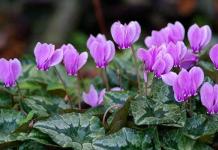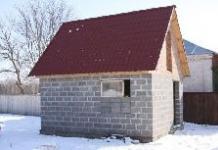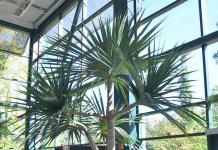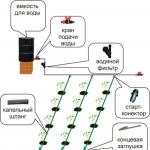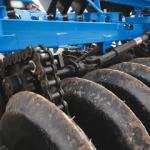Pandanus, or Pandanus, is a plant from the tropics, brought to us from the islands of the Indian Ocean. It resembles a palm tree with thin, spirally arranged leaves. In an apartment, the pandanus does not bloom, does not bear fruit, but this is fully compensated by the high decorativeness of the plant itself. Pandanus care at home can be organized even by a beginner in floriculture.
The genus consists of 600 species. Most of the representatives are tall tree-like plants. There are instances of 15 meters or more. Sometimes they form voluminous shrubs. Despite the resemblance, this is not a palm tree - the pandanus has nothing to do with it.
As a support and a means to obtain moisture, long aerial roots are released. An interesting sight is presented by plants with a dead basal part of the trunk. They are held above the ground on aerial roots.
The shape of the leaves is xiphoid, the edges are sharp-serrated. On the stem are attached in a spiral. The lower leaves gradually fall off, leaving scars on the stem. The barrel takes the form of a screw. The flowers are small, yellowish, form dense inflorescences.
As a houseplant, pandanus is more suitable for spacious apartments. It grows very quickly, puts up with dry air, easily tolerates a short-term lack of watering and low light.
Important! Pandanus leaves have a serrated edge, and the central vein is covered with thorns. Be careful when transplanting. Wipe the leaves from the trunk to the top - in the direction of growth of the spines. It is undesirable to keep a flower in an apartment where there are small children - it is easy to get hurt on sharp thorns.
Varieties for growing in an apartment
Of the 600 species that grow in nature, only a few are suitable for home cultivation. They differ in more compact sizes - they do not grow above 3 meters.
- Pandanus Veycha. The trunk is shortened. Produces many aerial roots. Leaves grow spirally, close to each other. The length of the leaves is up to 80-90 cm. The color is intense, green. Light stripes run longitudinally. The presence of spikes along the edge of the sheet is characteristic. Compact variety - grows on average up to one and a half meters.
- Pandanus is useful. Higher view. Grows up to 2-3 meters. The leaves are straight, branched, grow in a spiral. Color is rich green. Long - up to 1.5 meters. There are red spikes along the edge of the leaf.

- Pandanus sander. The trunk is shortened. Leaves up to 80 cm. Background - green, stripes - yellow. The edges of the leaves are covered with small thorns.

Enabling environment and care
Pandanus is unpretentious. The creation of special conditions for its cultivation is not required. Responds to intensive care with rapid growth and high decorativeness.
- Lighting. Will grow anywhere - in the sun or in partial shade. Variegated species do not put in the shade - the characteristic color becomes faded. At a young age, grown on the windowsill. Adult plants are placed in tubs on the floor, if possible - closer to the window. To avoid curvature of the trunk, the flower is regularly rotated around the axis.
- Temperature. Temperature regime - 20-25 ° C. In winter, do not allow a drop below 16 ° C. They try to avoid drafts.
- Humidity. Doesn't play a big role. Grows in both low and high humidity. Spraying is not recommended. Water accumulates in the sinuses, leading to rotting of the stem. For hygienic purposes, wipe the foliage with a damp sponge.
- Watering. A large mass of leaves requires enhanced watering. The water temperature is 30°C. In winter, pandanus growth stops - watered less often. The frequency depends on the temperature. The lower it is, the less often watering.
- Top dressing. Any fertilizer for deciduous crops is suitable. Observe the dosage and concentration indicated in the instructions. Frequency - 2 times a month. It is not recommended to fertilize dry soil. Optimally - on the day of watering.
- Transfer. The root system is sensitive, vulnerable. Transplantation is resorted to in extreme cases, it is replaced by transshipment. Young specimens have to be transshipped annually due to rapid growth. Adults - if necessary, replace the pot. Aerial roots are left outside. Tanks are used heavy, stable, approximately the same width and height.
- The soil. Use nutrient soils with a high content of minerals. Soil mixtures are suitable for palm trees. Sod land should prevail in the soil for adult plants.
Advice! Pandanus can be used not only for landscaping, but also for air purification. Its large leaves absorb harmful substances, release essential oils into the air and enrich it with oxygen. Essential oils have an antibacterial effect, destroy pathogenic microflora.
Reproduction methods
They practice seed and vegetative propagation of pandanus. It grows longer from seeds, but eventually forms a full-fledged "palm tree".
- cuttings. Cuttings of 20 cm each are cut from long side branches. It is not recommended to use short cuttings - the process of root formation will go very slowly. Sections are immediately treated with activated carbon powder. They make up a substrate of peat and sand. Take them in equal proportions. Cuttings are planted in separate containers, under cover. The temperature for fast rooting is 25-28°C. The greenhouse is periodically ventilated, the cuttings are watered with a root growth stimulator. Rooting takes 1.5-2 months.
- Sowing seeds. Seeds are sown without prior preparation. Keep under film at 25-27°C. Germination is quite fast - it takes about 10-15 days. Seedlings are regularly watered, the greenhouse is ventilated. The first pick is in the stage of three true leaves. The use of bottom heating accelerates germination.
- The division of the bush. Use child sockets with a developed root system (20 cm). The socket is cut off from the main plant. If the roots are short, their growth is stimulated. Sphagnum is attached to the base of the outlet, periodically moistening it. Planted out in the spring. Cut off sockets are dried for a day before planting. Planted in a separate pot. Fill it with alternating layers - drainage, main soil, river sand. Sockets are planted and covered with foil. Shelter is removed from mature plants. Lower heating, maintaining the temperature at 25°C accelerates the rooting and adaptation of the young plant.
Important! Aerial roots should never be cut off. With their help, the pandanus receives additional moisture from the air. At low humidity in the apartment, air roots do not form. This leads to a loss of stability, the need to use props.
Common problems and diseases
It can be affected by all common indoor pests - spider mites, aphids, scale insects, mealybugs. If insects are found, insecticide treatment is carried out. Severe violations of the content recommendations can lead to a decrease in decorativeness.
Pandanus is of interest to beginners and experienced flower growers. The main advantages are unpretentiousness, high decorativeness, rapid growth, the ability to purify the air.
Pandanus was first discovered in humid forests on the islands of the Indian Ocean. The plant can be seen in Vietnam, Australia, the Marshall Islands, Madagascar and Java. Pandanus grows in tropical forests, along river banks and on sea coasts.
Under natural conditions, the plant is a shrub that looks like a palm tree. A common resemblance was the spiral arrangement of the leaves, which is why the plant is often called a screw palm.
In some Southeast Asian countries, pandanus palm leaves are used by the locals for cooking as they have a subtle spicy flavor. They wrap rice, meat, fish. Various household items are woven from the leaves, they are used to stuff mattresses. Thick palm trunks are used to build rafts.
Pandanus has several other names. Fans of indoor plants call it screw pine, corn, pandan.
 The shrub was brought to Europe from the tropics of the Old World, so the flower needs a lot of moisture, sunlight and very humid air. Previously, the plant was bred in greenhouses and winter gardens, because over time it acquired a huge size and required special conditions. With proper care, the pandanus begins to bloom with amazingly beautiful flowers and bears fruit. Indoors, pandanus flowering is almost impossible to achieve.
The shrub was brought to Europe from the tropics of the Old World, so the flower needs a lot of moisture, sunlight and very humid air. Previously, the plant was bred in greenhouses and winter gardens, because over time it acquired a huge size and required special conditions. With proper care, the pandanus begins to bloom with amazingly beautiful flowers and bears fruit. Indoors, pandanus flowering is almost impossible to achieve.
Pandanus attracts special attention of lovers of indoor plants with its luxurious appearance, large size and simple care, which allows you to grow a beautiful ornamental plant.
Description
Under natural growing conditions, there are plants in the form of a shrub no more than one meter high and huge trees reaching a height of 20 meters or more.
The pandanus flower has a thick branching trunk covered with smooth or warty bark. The root system is very powerful. A significant part of it is on the surface in the form of air layering and stilted roots. This is necessary in order to keep the massive trunk and spreading crown with long leaves and fruits from gusts of wind.
 The leaves are arranged in several tiers. Sheet platinum is quite long, their length can reach two meters, and their width can be 1.5 meters. The edges of sheet platinum are hard and have spines.
The leaves are arranged in several tiers. Sheet platinum is quite long, their length can reach two meters, and their width can be 1.5 meters. The edges of sheet platinum are hard and have spines.
Pandanus is dioecious plant, whose male and female flowers have external differences. Male flowers have an elongated shape and exude a delicate aroma. The female branches are round, surrounded by bracts.
Pandanus fruit - drupe, combined into a single spherical fruit, and outwardly resembles a pineapple. As the fruit ripens, its color changes from green to orange or red. The fruits can stay on the tree for more than a year.
At home pandanus unpretentious. For its successful cultivation at home, the florist does not require any special skills and knowledge. Even a novice grower can grow an indoor screw palm tree. At home, the flower can grow to gigantic sizes, so most often it is kept in spacious rooms with high ceilings.
plant species
About 600 species of false palm grow in natural conditions. At home, you can grow a screw palm of several types.

Pandanus: is it possible to keep at home
 Many believe that the palm tree should not be kept in living quarters. Bioenergetics believe that it radiates a lot of negative heavy energy. The “bad” energy of the pandanus is also associated with the arrangement of thorns along the edges of the leaves, which protect the surrounding space.
Many believe that the palm tree should not be kept in living quarters. Bioenergetics believe that it radiates a lot of negative heavy energy. The “bad” energy of the pandanus is also associated with the arrangement of thorns along the edges of the leaves, which protect the surrounding space.
The only trouble that can be associated with growing a flower at home is pricks with thorns. If there are small children or pets at home, the flower should be placed at a safe height to protect the inhabitants of the apartment. You should also be aware that after an injection, an allergic reaction may develop in the form of skin redness and itching, since the plant sap is poisonous.
The positive qualities of the pandanus should also be noted. In places of natural growth, the shrub is valued for its healing qualities, since its leaves have analgesic and anti-inflammatory properties. It is used to relieve toothache, used to treat inflammation of the oral cavity.
Home care
- Location and lighting
 When placing the plant, you should be aware that the pandanus flower requires a lot of free space. When in contact with furniture, the leaves stop growing. False palm leaves have thorns located along the edges, which can be easily scratched, therefore, when choosing a variety of palm, one should take into account the possibility of keeping it in an apartment after 5-6 years.
When placing the plant, you should be aware that the pandanus flower requires a lot of free space. When in contact with furniture, the leaves stop growing. False palm leaves have thorns located along the edges, which can be easily scratched, therefore, when choosing a variety of palm, one should take into account the possibility of keeping it in an apartment after 5-6 years.
Pandanus does not tolerate direct sunlight and lack of light. When placing, you should stay on the western or eastern side of the apartment. The most suitable for panandus is diffused bright light.
With a lack of lighting, you can additionally illuminate the shrub with a phytolamp, which is placed about one meter from the pot with the plant.
The plant should not be taken out into the open air, where the leaves sag, dry out and lose their decorative effect.
In order for the crown to develop evenly, the pot should be rotated periodically. This will prevent the leaves from pulling out.
- Temperature
The palm tree is grown in a warm room, the air temperature in which should be above 20 degrees. The plant is very afraid of drafts and cold air. It is allowed to ventilate the room for a short time.
- Watering and humidity
 The plant requires moderate humidity. In a dry room, the tips of the leaves begin to dry out, so it is recommended to wipe the leaves with a damp cloth or sponge.
The plant requires moderate humidity. In a dry room, the tips of the leaves begin to dry out, so it is recommended to wipe the leaves with a damp cloth or sponge.
Watering is carried out only on the roots. It is unacceptable to get moisture into the axils of the leaves; therefore, it is strictly forbidden to wash the panandus in the shower. For irrigation, warm water is used, the temperature of which is several degrees higher than room temperature.
When caring for the plant, you should take care of your hands, because the leaves of the plant are covered with poisonous thorns.
To feed aerial roots, flower growers use moss, which is laid around the roots and periodically moistened.
- Transplant and soil
 As the plant grows, it is transplanted into a larger pot. Young plants are transplanted once a year, adults - once every 2-3 years. Transplantation is carried out after the root system completely entwines the earthen clod.
As the plant grows, it is transplanted into a larger pot. Young plants are transplanted once a year, adults - once every 2-3 years. Transplantation is carried out after the root system completely entwines the earthen clod.
For the plant, you can use ready-made soil compositions for palm trees or prepare it yourself by mixing sheet soil, humus sand and clay.
The transplant is carried out transshipment method. The plant should be carefully removed from the pot without damaging the fragile root system. The leaves are tied before transplanting so as not to damage the hands. A new pot should be laid with a thick layer of drainage. The plant is planted at the same level, no additional deepening is required.
Adult plants do not need to be transplanted, so you can limit yourself to replacing the topsoil.
- plant formation
Special crown formation is not required. The lower leaves, dying, form a helical trunk. Over time, many daughter plants grow around the main plant, which flower growers do not remove so that the plant looks more lush. As a result, not only a dense crown is formed in the mother plant, but also a lush trunk.
In youth, pandanus is often confused with dracaena and bromeliads. And in adulthood, when its stem becomes bare, forming a powerful trunk with spiral-shaped leaf scars, it is mistakenly referred to as palm trees. But in fact, this unusual plant comes from a large pandanaceae family.
There are over 600 species in the genus, which are common in tropical areas (Africa, Madagascar, Australia, etc.). An exotic bush quickly turns into a powerful tree. Its height in nature can reach 15 meters. Pandanus leaves are elongated with jagged edges, the length of different species is from 30 to 90 cm. In some pandanus leaves twist spirally relative to the stem, which served as the basis for the second name "screw palm".
There is one amazing feature of this plant. Over the years, many so-called stilted roots form on the trunk of the pandanus. These are aerial roots that serve as an additional source of nutrition and support when the lower part of the trunk dies. In no case should they be damaged, cut, dropped.
Another feature is that the locals cultivate pandanus for delicious fruits. After flowering, some species (P. utilis, P. fragrans, etc.) form red or yellow fruits. It looks like a pineapple.
Pandanus feels great as a pot culture. Only now exotic fruits, and flowering at all, do not have to wait. But with minimal care, you can grow a fairly large sprawling specimen.
COMMON PANDANUS TYPES
- Pandanus Veycha (P. Veithii) - ornamental species, often grown at home. Reaches up to 1.5 m in height, leaf length - 60-90 cm.- Pandanus Sander (P. Sanderi) - also a rather large species with a short trunk, large leaves up to 80 cm with longitudinal yellow stripes.
- Pandanus dwarf (P. Pygmaeus) - small size. The height of the plant is about 60 cm, the length of the leaves is up to 40 cm.


HOME CARE
Due to its large size, pandanus is most often grown as an outdoor plant, located in the back of the room. In principle, the plant does not need direct sunlight, but if the species is variegated, there may be a lack of sunlight, which affects the color of the leaves. It is better to shade from direct sunlight: burns are possible.Temperature for a pandanus, an ordinary room is suitable. The main condition is that it does not fall below + 15 ° C.
Humidity air also does not play a significant role. Spraying is not recommended. If water enters the axils of the leaves, rotting may occur. But aerial roots, if any, are sprayed or wrapped with wet sphagnum moss. Dust leaves are wiped with a damp sponge. In this case, one should not forget about the sharp edges, and also about the spikes growing in the middle of the inner side of the sheet.
Pandanuses watered plentiful in summer. Due to the large leaf area, the plant evaporates more moisture. But when the air temperature drops, so that there is no rotting of the roots, they irrigate the earth only after the top layer of the soil dries out. Watering should be warm and soft water. Sometimes bottom watering is used so that the plant absorbs as much water as it needs.
fertilizers use complex, for ornamental plants. Apply only during the period of active growth (spring-summer) once every two weeks.
Transfer for young plants, it is necessary once a year by transshipment, so as not to damage the roots. Adult species are transplanted as they grow. Pots choose large, stable. Roots-stilts do not fall asleep with earth.
soil for pandanus must contain nutrients. The following composition is suitable: turf, leafy soil, humus and sand. If it is not possible to prepare the mixture yourself, you can buy soil for palm trees in the store. It is also suitable for "screw tree".

Pandanus is propagated in three ways:
- Cuttings. Cut cuttings 20 cm long from side shoots. The cut is dried for several days and planted in a mixture of soil and sand. Be sure to create a greenhouse, cover with film or glass and ventilate regularly. Roots are formed after 1.5-2 months.
- The division of the bush. Daughter plants are formed on an adult pandanus. In order for rooting to be more successful, young rosettes need to be allowed to grow by about 17 cm, and only then they can be cut and planted in the ground. This method is considered the most reliable.
- Seeds are propagated mainly in the homeland of the plant. But if a delicious pandan was brought to you, you can experiment at home.
The tips of the leaves dry. This means that you should increase watering, or increase the humidity in the room.
If the leaves have lost their brightness, then the plant does not have enough sunlight, additional illumination is needed. But abuse, excess sunlight makes the leaves whitish.
Pandanus is an ornamental plant that is characterized by a bright and original appearance. It is great for a greenhouse or winter garden, but some enthusiasts place the plant right in the apartment. Before buying a pandanus, it should be noted that proper home care for a pandanus allows it to quickly reach a significant size, and therefore the correct location of the plant is a spacious and bright room with a high ceiling.
When placing a young pandanus in the house, it must be remembered that the edges and lower part of its leaves are equipped with sharp spikes that can scratch a child or pet. Despite these features, many lovers find it an interesting and attractive plant, especially since caring for a pandanus does not require special skills and a lot of experience.
Appearance and structural features
Under natural conditions, pandanus is found in the tropics of the Eastern Hemisphere. Its distinctive feature is narrow leaves, which are arranged in an ascending spiral around the trunk and have an unusual color - bright green with white stripes. The peculiar arrangement of the leaves led to the second name of the pandanus - the screw palm, although it has nothing to do with the palm family, apart from a certain external resemblance.
In addition to the original appearance, the pandanus is also unusual in its structure. Aerial roots form on its trunk, which gradually grow and become stronger. They make the plant more stable, and therefore they are called stilted. Under natural conditions, the lower part of the trunk dies off and these roots play the role of a system that supports the vital activity of the pandanus.

With the room content of the pandanus, the formation of stilted roots is not so active, mainly limited to small air roots. They should not be removed, the plant needs them for proper metabolism. Experienced flower growers advise in the summer to fix a layer of moss on them, which should be moistened periodically. A large plant grown in artificial conditions definitely needs to install a special support system that will perform the function of stilted roots, supporting it.
Pandanus in nature blooms and bears fruits that are quite edible, however, not in all species. With artificial cultivation, the screw palm is not able to bloom and bear fruit. Most often among indoor plant lovers, you can see the following three species: P. utilis (dark green leaves), P. sanderi (pandanus sandera - green leaves with white stripes) and P. veitchii (yellow border along the edges of the sheet).
The nuances of caring for pandanus
Despite the rather large dimensions, caring for the pandanus is quite simple. It must be placed in a bright place where direct sunlight does not fall. It should be remembered that insufficient illumination negatively affects the color of the variegated forms of the plant.
The optimum temperature for the pandanus to feel comfortable is at least +18 degrees. This heat-loving plant reacts strongly to the presence of drafts. However, one should not forget about timely watering, since with a lack of moisture, the tips of the leaves of the pandanus dry up.
Features of watering pandanus
The ingress of water into the axils of the leaves has a very harmful effect on the plant. Oversight during watering can lead to the death of the plant. For this reason, it is not worth washing it in the shower or spraying it with a spray bottle. Dust that has accumulated on the leaves can be gently wiped off with a moistened soft cloth.

To humidify the surrounding air, it is best to use a spray gun that disperses water into small sprays. Experienced flower growers use a different method - you can place a container with a plant on a pallet with moistened expanded clay or moss.
In the warm season, the pandanus needs abundant watering. As for the water for irrigation, it should be slightly warmer than the air temperature in the room. Experts advise using a pallet for irrigation, however, there are subtleties here too - the pandanus does not like stagnant water, and therefore excess moisture should be removed from the pallet.
Transfer
It is best to transplant pandanus in the spring. Young plants should be transplanted annually, adults - once every two to three years. A feature of this procedure is that it is necessary to pay special attention to the aerial roots, trying not to damage them. Particularly large plants are not transplanted, but the top layer of soil must be replaced in the spring. To protect against thorns, when transplanting, the leaves are tied from below with a dense cloth, lifting them up.
Pandanus breeding
Competent care at home for the pandanus involves the reproduction of the plant. All types of screw palm can be propagated by seeds, and in addition, Veicha and Sandera form side shoots on which aerial roots are located. These shoots take root quickly, for which they are simply cut off and placed in loose soil.
Reproduction of useful pandanus is carried out exclusively by seeds, which are sown in specially prepared soil based on peat and river sand. The entire plane of the soil is placed under a plastic film, moistening and ventilating it daily. Seeds germinate in 3-4 weeks.
One of the most important advantages of pandanus is its amazing resistance to diseases and pests. Perhaps the only enemy of this amazing plant is scale insects.
Pandanus (pandanus) is a very showy plant of the Pandanaceae family. Its bright crown consists of many long, spiny leaves. They are spirally arranged relative to the central axis, which is why flower growers also call the flower a “screw palm”. Pandanus is native to the African tropics, Madagascar and the forests of Polynesia. In our country, pandanus is grown as a houseplant. For ease of care, pandanus can be recommended to beginner flower lovers.
Botanical description
Pandanus is an evergreen perennial, in its natural environment it can reach more than 13 m in height. A houseplant rarely exceeds 3 meters in height. Thick, dense roots go deep into the ground. It is noteworthy that the flower has not only an underground, but also an air rhizome.












Above the ground is a smooth short trunk covered with light brown bark. It is almost completely hidden under sessile leaves. The top is decorated with a spreading crown of many belt-like leaves. They grow along the stem in a spiral. The leaves at the base are tightly adjacent to each other. The leaf has a pronounced central vein and a bright green color. The length of the plate is 60-120 cm, and the width is 3-8 cm. Short but very sharp spines are located on the sides of the leaf, as well as on the bottom along the central vein. They grow at an angle, towards the edge of the leaf.
In its natural environment, the pandanus screw palm produces flowers annually. On one tree, you can find male spike-shaped inflorescences and female cone-shaped flowers. As a result of pollination, large edible fruits are formed, similar to a rounded pineapple. They have a pleasant sweetish taste and contain medium-sized seeds. Alas, it is almost impossible to achieve flowering of indoor pandanus.
Types of pandanus
The pandanus genus includes 600 plant species, but most of them can only exist in the natural environment. Among the indoor copies, the most popular are the following:
This evergreen plant has a short tree trunk. Down from it, like stilts, lignified roots descend. Indoor specimens grow slowly, after a decade they are no more than 1.5 m in height. The xiphoid foliage fits snugly at the base and diverges in the form of a fan. The length of the leaf plate is 60-90 cm with a width of 5-8 cm. There is a contrasting white stripe on the sides of the bright green foliage. The edges of the foliage are dotted with light brown thorns.

The houseplant is a sprawling tree up to 3 m high. The old trunk can branch out. The top of the stem is crowned with a helical crown of drooping leaves. The leaf length is 100-130 cm, and the width is 5-10 cm. The dark green foliage has serrated edges and a keel.

Rigid belt-like leaves are 80 cm long, their width is 5 cm. Narrow yellow stripes and brownish spikes are located along the edges of the dark green leaf.

A dense shrub up to 4 m high has a branched stem. Its base is elevated due to aerial roots. The crown has a pyramidal shape and consists of hard, straight leaves of a single color.

In addition to the main species, there are several decorative varieties, which allows you to choose a pandanus with the most interesting appearance.
palm tree at home
Some flower growers are afraid to start a pandanus at home. The reason for this is unfounded superstition. They say that with its thorns it attracts negative energy. However, even fans of spiritual practices do not confirm this version.

At home, the plant is used as a fodder crop, as well as for weaving baskets. By chewing a pandanus leaf, the locals get rid of a toothache. The only cause for concern is the sharp thorns, so it is not recommended to put the palm tree in a place accessible to children.
reproduction
Pandanus flower can reproduce by seed and vegetative methods. Seed propagation is possible only in the wild, as seeds are planted with part of the pulp immediately after fruit ripening.
At home, a new plant can be obtained from lateral processes (children) or by dividing the bush. At the base of the stem between aerial roots, young shoots appear almost all the time. They have their own roots and leaf socket. When the process reaches a height of 18-20 cm, it is carefully separated with a sharp knife. Seedlings are rooted in moist sandy-peat soil. After 1-2 weeks, the plant will adapt and begin to grow.

Some types of pandanus do not release babies, so they are propagated by dividing the bush. It is necessary to cut off part of the leaf rosette with aerial roots. The place of the cut is sprinkled with crushed charcoal and dried in air for a day. The cutting is rooted in sandy-peat soil with the addition of sphagnum moss. Seedlings need to be covered and placed in a well-lit room with an air temperature of + 24 ... + 28 ° C. Every day, the greenhouse is ventilated and moisten the soil. Rooting is completed in 4-7 weeks.
plant care
The rules for caring for pandanus at home are simple. Even if the content is far from ideal, the plant looks good and grows in size. However, it will not be distinguished by its special beauty and large leaves. To achieve a spreading crown, you should follow a few simple rules.
Pandanus needs a long daylight and bright light, it can easily tolerate direct sunlight. The ideal place would be the eastern or western window sills. With a lack of light, the leaves lose their elasticity and begin to droop more strongly; the bright color disappears in variegated forms. In winter, with a short daylight hours, bright illumination should be used for 6-8 hours.

The optimum air temperature for an adult plant is + 22 ... + 25 ° C. Cold snaps below +15°C are detrimental to him. For the summer, it is advisable to take the pandanus flower to fresh air, but protection from strong gusts of wind and cold air will be required. Palma does not need an artificial decrease in temperature in winter.
Pandan is undemanding to air humidity. It responds well to wiping the leaves from dust and periodic spraying. You need to take care of the palm tree carefully so as not to get hurt on sharp thorns. When spraying or bathing, care must be taken to ensure that moisture does not linger in the axils of the leaves, otherwise rot will develop.
Pandanus needs abundant and frequent watering, however, between irrigations, the soil should dry out by half. Water for irrigation is taken purified and slightly acidified. Its temperature should be in the range of +25…+30°C. Reduce watering as it gets colder. You should focus on the condition of the soil.

In March-October, the plant is fertilized with liquid mineral compounds for deciduous plants. Top dressing is applied to the ground twice a month. They should be well diluted with water so as not to burn the rhizome.
Transfer
It is difficult to imagine proper pandanus care without a regular transplant. At home, it is carried out infrequently, since the aerial and underground roots of the plant are quite fragile. The plant is transplanted when the roots are completely braided with an earthen ball. The pot is chosen deep, a few centimeters wider than the previous one. The drainage layer should be about a third of the capacity. The soil for pandanus should be light and slightly acidic. It is made up of:
- hardwood soil;
- humus;
- soddy soil;
- river sand.
Transplantation is carried out by transshipment. Do not deepen the palm tree much. Aerial roots should remain on the surface. Care must be taken not to break them off.
